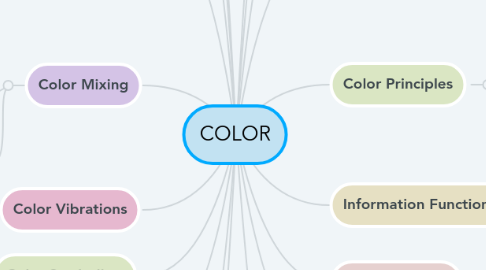COLOR
by helena Esteves

1. What is it? It is the property of light which divides itself in waves.
2. How Do we perceive it? Objects reflect parts of the light spectrum and absorb the rest. The reflected light is focused by the lens of the eye onto the retina—the cones and the rods.
3. Spectral Color
3.1. Ex. Prism Diamonds. Their wavelengths fall into the visible electromagnetic spectrum.
4. Hue
4.1. Hue: It is the color by itself.
4.2. Hue Circle: Red changing to yellow, changing to green, changing to blue, changing to red.
5. Saturation
5.1. High and Low Saturation Saturation describes the color richness.
5.2. Achromatic and chromatic: Colors with a hue are called chromatic colors. White, gray, and black are called achromatic colors
5.3. Desaturation: Color getting ligther with white light
6. Brightness
6.1. Brightness: Brightness, or value, indicates how light or dark a color appears and he it depends on how much light it reflects.
6.2. Brightness During Desaturation: all degrees of saturation show the same gray.
7. Color Models
7.1. They show a range of hues, saturation, and brightness.
7.2. L*a*b Color Model: L*a*b color consists of a luminance or lightness component (L), which we call brightness, and two chromatic components: the a component (from green to red) and the b component (from blue to yellow). The farther away a color is from the achromatic axis, the more saturated it is.
8. Primary Colors
8.1. Additive primaries: The additive (light) primaries are red, green, and blue (RGB).
8.2. Subtractive primaries: The subtractive (paint) primaries are cyan, magenta, and yellow (CMY).
9. Color Mixing
9.1. Additive Color Mixing: If you add green to the red light, you get yellow. If you add blue instead, you get magenta. If you add green and blue together, you get cyan. If you add all three light primaries together, you get white.
9.2. Subtractive Color Mixing: When all three subtractive primary filters overlap, we get black; they swallow one another’s light until no light is passed.
10. Color Principles
10.1. In Video: the standard cathode ray tube (CRT) color television receiver has three electron guns, each responsible for either the red, the green, or the blue signal.
10.2. In Painting: Pointillist: Paintings and color schemes are built by juxtaposing thousands of individual dots, all consisting of a few basic colors of varying saturation.
11. Color Vibrations
11.1. When intended, color vibrations can provide an exciting visual experience.
12. Information Function of Color
12.1. The information we get from a colored picture is richer than the one we get on a black and white,
13. Color Symbolism
13.1. Talk about how colors have a meaning.
14. Color Harmony
14.1. colors harmonize best when they are close to each other on the hue circle, on opposite sides of it, or on the tips of an equilateral triangle superimposed on it.
15. High-Low energy Color Distribution
15.1. set off a high-energy color against a low-energy background.
16. Color Distortion
16.1. Getting dramatic impact by changing tints in purpose
17. Color Saturation
17.1. Normal: give us more information about the event but do not necessarily intensify it
17.2. Desaturation: the scene becomes more low-definition and so more emotionally accessible. The desaturated colors do not prevent us from looking into the event.
17.3. Total, Black-and-white Image: In black-and-white the outer event often serves as an extension of the inner event.
17.4. Low-Definition Rendering: compelled to deal with an inner reality. Low-definition images force us to mentally fill in the missing parts and thereby become involved in the event.
18. How do we mix colors
18.1. Additive mixing with colored light: Putting a red slide in one slide projector, a green slide in a second projector, and a blue one in a third and overlapping them partially on a screen.
18.2. Subtractive color mixing involves filtering out, or subtracting, from white light all colors except the one it displays. Combining two or more such filters (or by mixing paint), you can again achieve a wide variety of hues. An artist’s palette is ample proof of such color variations.
18.3. Complementary colors: You may have heard of complementary colors that eliminate each other when mixed additively. For example, if you were to additively mix a blue light with a yellow light, you would not get the customary green as you would when mixing paint; you would get white light.
18.4. Mixed Mix: When lighting a set with colored lights (instruments that have color filters attached to them to produce a colored light), you may encounter additive and subtractive color mixing.
19. Color Temperature:
19.1. Our color perceptions are also influenced by the kind of light under which we experience them. Although we speak of “white light,” no light we ordinarily see is pure white. Some so-called white light has a reddish tinge; other white light is bluish.


